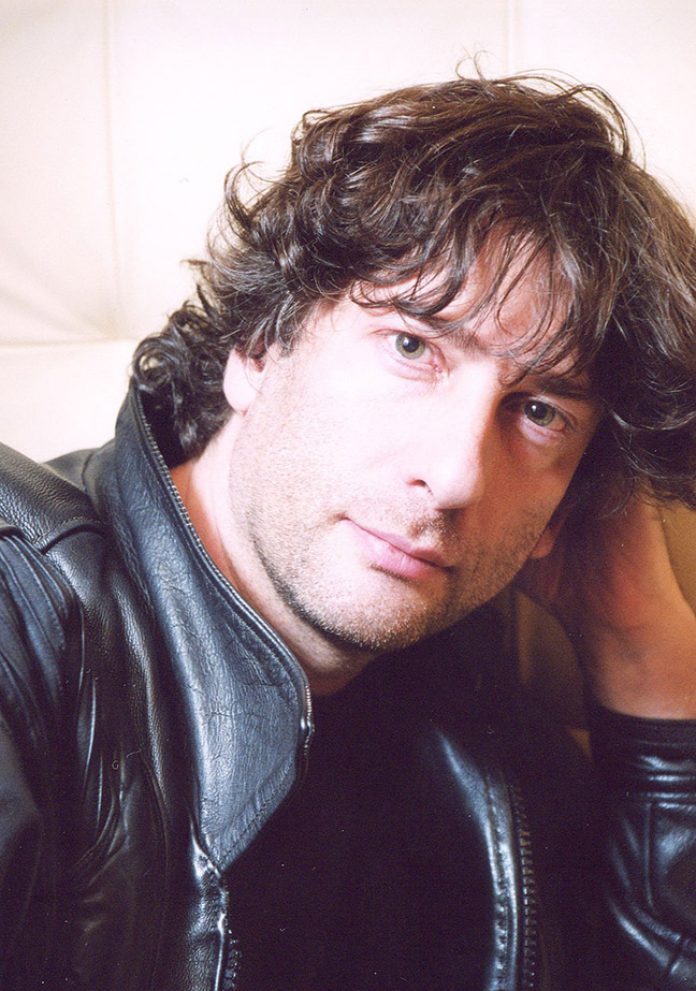
- 490shares
- Facebook444
- Twitter6
- Pinterest39
- Reddit0
- 0
- Like
- Digg
- Del
- Tumblr
- VKontakte
- Buffer
- Love This
- Odnoklassniki
- Meneame
- Blogger
- Amazon
- Yahoo Mail
- Gmail
- AOL
- Newsvine
- HackerNews
- Evernote
- MySpace
- Mail.ru
- Viadeo
- Line
- Comments
- Yummly
- SMS
- Viber
- Telegram
- Subscribe
- Skype
- Facebook Messenger
- Kakao
- LiveJournal
- Yammer
- Edgar
- Fintel
- Mix
- Instapaper
- Copy Link

There’s a time in your life that you may be rendered speechless and for me, it happened at a comic convention in 1997 when I was standing in line to get Neil Gaiman’s autograph. I was certainly the chatty lass while talking with my friends, all of us trying to keep warm in the ice cold convention room while the North Carolina sun was blazing outside. But the minute I approached the table, Neil opened his mouth and the most beautiful voice came out, and I fell silent. Not to mention his good looks that I think even men are a bit taken aback by. He started talking to us and I cannot recall what he said because I think all that was going through my mind was, “This man has the most incredible voice, this man writes one of my two favorite comics, wow, this man is really hot! He has a wife, right?” And to answer that question, yes, he’s happily married with children.
Fast forward to a sunny afternoon in September and I’m nervously dialing the numbers to interview Neil and praying my voice doesn’t crack or fail me completely like it did years ago.
A chipper female voice answered the phone, it was Lorraine, his assistant and she quickly informed me she had Neil ready and patched me through. Barely a pause, and then there was that honeyed voice with the English accent.
“Hello.”
Hello Neil, how are you doing?
“I’m good. Who are you?”
I’m Anastasia from Gothic Beauty magazine.
“I knew you were from Gothic Beauty, because that’s not a name of a magazine that I forget easily.”
How do I start a conversation with one of my favorite authors? Quickly, because this was a busy man and I had very little time to ask him all the things I wanted to.
It seems there’s a wide and varied audience for your works. Once, I read my mother a selection from Angels & Visitations, while she was cooking dinner, and she liked it so much she asked me for your books for Christmas. Your last book, American Gods, received high acclaim, a different departure from NeverWhere and an even more drastic departure from your comic series, Sandman. But it seems when it comes to your works, your fans will read everything you write, what is the appeal do you think?
“I think part of it, and I don’t know that it works, formally or universally, but part of it is the fact that I have very little interest in doing the same thing again. So, which is really meant to be the kiss of doom for an author. If you want to be famous and if you want to be successful, it is widely held truth that you should pretty much do the same thing over and over again. And find your audience and be nice and predictable. You know Robert Ludlum is not meant to suddenly go off and write a comedy about going to Disneyland. I’m incredibly lucky, I think partly because I came out of comics, which is a medium that people mistake for a genre. While I was doing comics, I was allowed to do anything I wanted. In Sandman, over four issues I went from a horror story about a man keeping a muse in an attic to a story about cats and what they dream, completely from the point of views of cats with almost no people in it, to a historical story about the first ever performance of A Midsummer Night’s Dream to a sort of weird downside of super hero psycho thriller about a suicidal super heroine being depressed in her apartment all day.”
Perhaps the medium is a tad bit more forgiving than others maybe?
“Well yes, because nobody minds the fact because it was all comics. So nobody particularly noticed, which meant that I got spoiled, which means that when I move out and do other things, I have absolutely no desire to write the same thing I did last time. And commercially I would be, while I’m obviously not doing badly for myself at all, I would be much much richer if I turned around to my publisher tomorrow and said ‘My next three books will be Neverwhere two, American Gods two, and Coraline two, give me a contract.’ They would say ‘Great, how much do you want? Fill in the zeros.’ But that’s never really been what I’ve been interested in, I wrote those books. And it’s possible, you know, I definitely have at least one more Neverwhere story that I’d like to tell. But mostly I just like to keep moving. The novel I’m writing right now is the thing called Anansi Boys, and it’s a comedy, I hope. The first comedy I’ve wrote since Good Omens. And it’s very different to Good Omens, but basically it’s sort of a very strange, almost situation comedy. Which I thought ‘Well, I haven’t written a funny book in years’ and I’d like to write one that was… that would be fun to write a novel that’s halfway between sort of P.G. Wodehouse and Thorne Smith and those guys. And I’m allowed to, no one’s going to complain. Which is such an amazing position to be in. I write Neil Gaiman books. And I get to live in this strange world in which I’m either terribly famous or utterly unknown.” We both laugh at this. I feel almost relaxed, sitting deep in an overstuffed chair surrounded by books in a huge library, and I’m left with the sense that with one word from Neil, we could be in another world of his choosing. This is the power of his voice even over the phone.
“I don’t have that gray area that I don’t know, Anne Rice or Stephen King have, where you talk to people and they’ll say, ‘Well I’ve never actually read any of their books but I know who they are.’ If you’ve never read me, you probably have no idea who I am cause I haven’t registered on your radar at all. Whereas if you’ve read me, you probably have strong opinions one way or the other. Although then again the whole weblog thing is sort of mucking that up these days. There are so many people reading the weblog that have no idea who I in terms of writing, but they just know they like reading this… this thing.”
It’s hard to pinpoint Neil’s style of writing, it seems to change, yet you always know it’s him. What it comes down to is he’s a master of his craft, storytelling.
“I’d love telling stories. The story is the big important thing and everything else is minor… Writing American Gods was interesting for me because I tried very very conscientiously to write it in a style that I tend to think of as American meat and potatoes. Which is halfway between Elmo Lynner and Stephen King and those guys where the author is an invisible presence. Where there’s very very little pretty writing, there’s almost nothing that draws your attention to the fact that anybody is writing this at all. And I thought that would be the right style to write that in. You know, whereas, something like Stardust is written in a sort of 1920’s style. I actually went out and bought my first fountain pen.”
You hand wrote that?
“Yes, cause I felt I needed to… up until then I dumped pretty much everything for the last, you know, the previous ten years had been done on computer. And I thought ‘You know, I want a different kind of rhythm and a different sound’ so I went out and bought myself a fountain pen and a big book and sat down and started writing Stardust. I liked what it did to the sentences. I also like the fact that it gave me a first and second draft.”
Do you find yourself writing certain stories in certain places? I know in American Gods I was reading you were in a lot of different places when writing that book. So do you go someplace to become more inspired for one story then you do for a different kind of story?
“Occasionally yes. I was a journalist, which means that I can write anywhere at the end of the day. You had to write in a loud newsroom an article at exactly 750 words with someone at the other end of the room waiting for it. I’m very good at tuning out and just writing. But I love going away, I love writing places that I haven’t been before, I love feeling slightly uncomfortable. If I go somewhere else, I go somewhere that’s out of the usual, it’s not my home, I’m not surrounded by my usual things and stuff, I can actually get into the kind of rhythm where I pretty much will write for 18 hours a day and go to bed mid sentence and get up the next morning and carry on. Which I can’t do at home. There’s things to be done at home. The garbage has to be taken out. Going and talking to my daughter’s class about what it means to be English. Life carries on. Whereas if I go somewhere else I can sort of write twice as much in half the time. So I tend to do that. The other thing I love about going somewhere is the traveling. People ask where do you get your ideas and there are lots of places I get my ideas from. But being bored is a very good one. Especially being bored some way you cannot leave. So long drives are absolutely as good as going to something incredibly dull at the theater. Or going to a rock concert that turns out not to be very interesting after all or whatever because you can’t leave and so I start just making things up. That’s the point I began imagining most.”
To go for a moment back to comics, a lot of people discovered your work through the Sandman series and for many people that was the only comic they ever read. Or it actually brought them into comics, later leading them to the super hero genre or something. How does it feel to know you’ve crossed so many boundaries, that you brought people that would never step foot into a comic shop to actually anticipate the next issue of Sandman? And then they later discover people like Alan Moore or Warren Ellis.
“It feels very good. That was part of the agenda. When I started writing comics, in fact before I started writing comics, back when I was journalist writing about comics, I was an evangelist. I was absolutely out there, with you know, handing people copies of Watchman, handing people copies of Maus, handing people copies of The Dark Knight Returns and saying ‘Read this it’s good, you’ll like it.’ And, you know, talking to other journalists. Having Sandman particularly, I got to write the kind of comic I would like. And I thought ‘let me just write a comic with literary sensibilities that does all the stuff that I enjoy’. Then I was very lucky because other people liked it too. The last Sandman comic came out, and this comic store owner is coming up to me, clasping my hand in their hands and saying,” And Neil shifts his voice down a few octaves, makes it gruffer, with just a hint of a mafia hit man. “‘Man I’ve got to thank you, you’ve brought women into my store.’ And I’ve never yet once said, ‘You know if you swept the floor, they might come back.’” There’s pause for laughter and he continues, “If I did anything, I think the biggest thing I did was just help break down this peculiar gender divide. I was very lucky, you know, it [Sandman] grew very very slowly. But as far as I can tell, was sexually transmitted. Guys would be getting Sandman and most of them would have said to their significant females ‘please read comics’ and the females would look at them and go ‘I don’t read those things’ and then one day they’d say ‘Hey look Sandman, read this.’ and the female person would read it and go ‘where are the rest of them?’ And then what would normally happen is when they broke up the female person would now go out and normally would have the Sandman’s with her, and then get a new male person and say ‘read these’.”
It seems in the goth subculture there’s two comics that are the mainstay, The Crow and Sandman, with Johnny the Homicidal Maniac and GloomCookie following as close seconds. How did you ever come up with the skeleton for the Sandman series? The basic idea for when you came up with the Endless.
“I came up with it all backwards, which is probably the best way to come up with something like that. If somebody had told me, ‘hey, your job is to create a new mythology to the millennium’, I would have told them to shove it. But luckily nobody ever said that to me and it never occurred to any of us that was what we thought we were doing. I had an idea originally for a Sandman story, just using the idea that DC had had a couple of characters called the Sandman who existed in people’s dreams. And I pitched one of them to Karen Berger, this editor, while we were working on Black Orchid. And DC Comics was worried that Black Orchid was not going to work because it’s two guys you’ve never heard of doing a character that nobody had ever heard of, a female character at that, and female characters didn’t sell and here we were doing this pacifist feminist ecological fable. So they said would I write a monthly comic and I said sure and I pitched them four or five different characters and they came back to me and said either they’re all used or we don’t think we should, but what about that Sandman idea you had but can you make it a new Sandman. Create a new character. So I thought okay, obviously I’ll go all the way on this, I’ll make him the Lord of Dreams. I thought well if you use the Lord of Dreams, why haven’t we heard of him before? And I thought maybe he’s been imprisoned, and I thought what a great idea for the start of a story. Somebody spending seventy years in a glass cell just waiting for everybody who’s imprisoned him to grow old and die. And who can out wait them. I kept looking up dreams in books of quotations and things and there would always be quotes along the lines of sleep is the brother to death. I kept thinking obviously there’s got to be more than one of these things if there’s a Lord of Dreams there has to be a something else out there. And Death obviously would be one of them. Then it occurred to me that people, for some reason I didn’t understand, had never really looked at families in comics before. And sibling relationships. And the weird tensions of love and hate that sort of power families. In fact, later on when it came out, people would come up to me and they say, ‘we love the Endless, they’re a dysfunctional family’. And I’d say, ‘what does that mean’ and they would explain it to me and I discovered what you call dysfunctional families in America are what in England we just refer to as families. So anyway, that’s the way they sort of got plotted.
“I never expected Sandman to go for longer than a year. These days if a comic is not doing very well, they will cancel it immediately. In those days, you always got twelve issues. I expected that issue eight the phone call would come down and say, ‘by the way we’re canceling this, it’s been a minor critical success and a complete commercial failure, you have four issues to go’. Which is why I planned my first year as an eight issue story line followed by a few short stories till the end. Except when we got to issue eight, instead of being canceled we were selling more than anything like that had ever sold before.”
Some people have claimed you’ve based these characters off real people from naming Tori Amos as the inspiration for Delirium or even naming themselves as the inspiration for Death! Can you put this rumor to rest for us? Was it just completely out of your imagination?
“Yeah, I mean there are some weirdnesses out there. There’s one lady, who I won’t embarrass by naming, but there’s a lady out there who lies on the web, which I find hilarious, claims to have been the cover model for the various photographic models and claims to be the inspiration for Death, to have modeled for Dave McKean on all of these covers. And, in fact, somebody sent me a link to some site where somebody interviewed her and she was talking about how incredibly sweet I was and she had one of these photo sessions and Tori Amos turned up and it’s completely lies. And sort of amusing lies in a way because then you go look at her webpage and she’s got all these photos of different women up claiming that they’re all her from the covers of these things. Dave would hire top models from London modeling agencies, who would come down, have their photo taken, go away and probably had no idea about it. Dave certainly didn’t fly out to California. So yeah, you get things like that where people will just lie which is bizarre.
“Then there’s things like people saying ‘well, obviously Tori was based on….I was about to say Tori was based on Delirium… ‘but that Delirium was based on Tori’. But actually, I didn’t meet Tori until September October 1991 and Delirium had been in the comic quite a while since then. The only one that is true which is visually Death was based on somebody I have never met, which is a friend of Mike Drigenberg’s, called Cinnamon, who was his model for the first Death drawing. And my plans for Death, I was going to have her look like a young Nico, back when Nico was the most glorious thing in the world, that very blonde ice queen sort of look. Then Mike did the drawing which has gone on to become vaguely famous ‘how would you feel about life if Death were your older sister’ drawing. And he sent it to me and I looked at it and I went, ‘oh, that’s what she looks like’.”
He went on to tell me about the day he got the drawing, he went into My Old Dutche Pancake House with Dave McKean in Chelsie, and their waitress, who was wearing all black and a silver ankh (which was unlikely at the time), bore a striking resemblance to the drawing of Death. Neil debated about showing the waitress the drawing, but Dave and his English sensibilities restrained him saying it would be ‘embarrassing’. So he was left saying nothing more to this ‘astoundingly beautiful’ (but in a way that is accessible and friendly) woman than ‘I will have this pancake please’.
“Now the weirdest thing about Death, which I don’t think I can claim any kind of particular credit, it’s just one of those things that’s happened. I love the way the character has spread out into society. You get girls who dress like Death, but don’t know about Sandman. They don’t realize they’re dressing like Death because they’re dressing like somebody who’s style they liked, who was somebody who was dressing like somebody who’s style they liked. The point I realized we were having some very peculiar impact was the point where Death the High Cost of Living came out and I gave her a top hat because I thought it would be fun. About 3 or 4 months later, I’m on tour and there’s girls with top hats in the signing lines. And I start hearing more and more about girls wearing black silk top hats. And I’m absolutely not saying that every girl wearing a black top hat, dressed in black got it from Sandman, because the whole point as far as I’m concerned is they didn’t. You start something and it would wander out and like some kind of magical mean into society.”
There is something besides Sandman, that a lot of fans know Neil for, and that’s his passionate support for the Comic Book Legal Defense Fund. I asked him why he got involved, what was the defining factor that pushed him to be such a voice for them?
“The defining factor for me was coming and living in America. I came from England, there is no guaranteed freedom of speech in England. You have the official secrets act, the obscene publications act, you have a bunch of customs laws in which offensive publications were actually slipped into a law written for the importation of noxious PLUMS(?) which actually allows customs quite legally not only to confiscate anything they object to, but to confiscate anything in the same shipment in case it got infected. There is no freedom of speech in England, you don’t have it, it doesn’t exist, it is not a legal right. Coming to America where you have this thing, I was going ‘this is absolutely amazing, look I just bought books by the Marquis De Sade’ you can’t buy them in England, you can’t even take them back into the country because they will be confiscated. I’ve always wanted to read 120 Days of Sodom, now I’ve read it, I wish I hadn’t!
“I felt like it was this thing that people were taking for granted. Comics are very very easy to attack and they’re very easy to prosecute. When 2 Live Crew got into trouble in Florida, the entire record industry gathered around and it’s a multi billion dollar industry and everybody backed down.
“When Pensacola, FL put Mike Diana into jail for 3 nights for doing his own comic, Boiled Angel and he became the first American artist to be prosecuted for obscenity and convicted. When he was sentenced to 3 years suspended sentence, 1000 hours community service, $1000 fine, psychiatric treatment at his own expense, forbidden to be within 10 feet of anybody under the age of 18, which considering he worked in a convenience store meant he couldn’t work anymore and that the judge added that he was forbidden from drawing anything that could be considered obscene and that the local police force were required to make 24 hour spot checks randomly of Mike’s residence and to simply break in to make sure he didn’t have time to flush any of the art he was creating down the toilet. Nobody made a fuss, it didn’t get into Time magazine, nobody knew about it. The Supreme Court declined to rehear it. CBLDF managed to get it at least in front of the Florida Court of Appeals where they allowed him to leave Pensacola. He was allowed to go to NY, where you may be surprised to know, the police are actually too busy to make random spot checks.
“I think things like that are so fundamentally wrong, that getting out there on the road doing things for the CBLDF was absolutely a no brainer.”
With the success of Sandman and two Death mini series, rumors will always run rampant about movie adaptations. For years talks have been rumbling about a Death movie and just recently it was announced that Neil had written a script.
“Mirror Mask the film I wrote for Dave McKean, is almost finished and should be released early next year. That completely took me by surprise that it suddenly got green lighted. But everything seems to be chugging along with Death, we have a script that everybody likes. A year ago it looked like everything was going forward and then Warner Brothers said they couldn’t do it because it wasn’t big enough. Eventually Warner let us take it to New Line. We have our Death, we have a budget, but there are so many things that can go wrong. If it happens, it will be great. It’s a good movie I think, I just took the graphic novel and expanded it.
“One of the things I’ve had to now think about is I’m going to have to figure out a style for Death. When we created Death there wasn’t any sort of… well, there weren’t things like Gothic Beauty! This is not something that existed particularly. Yes, there were some goths, but they were very few in number because goth was something that had happened in London for half an hour, after the New Romantics in 1981 or whatever and was now done. I don’t think Cinnamon would have identified herself as a goth. We weren’t going okay, ‘We’re going to create a gothy looking comic’. We were just creating people who kind of dressed like we did. I still want that look, but I need it to be more universal, I don’t want people to look at that character and go, ‘oh yes, a goth’. I want them to look and go, ‘oh, she’s gorgeous… and she’s so nice.’ So it will be interesting having to figure out essentially a look that is completely consistent with the character so far and also allows us not to pigeonhole her. So that will be fun.”
The conversation didn’t end there, but as with everything it seems, there are time and space restraints. Speaking to Neil left me with an intense desire to hop in the car and take a long road trip to the end of nowhere where we could dine on something hard to find but delightfully tasteful and talk for hours over coffee. For now, we’ll have to contend with the upcoming release of his DVD, A Short Film About John Bolton from New Video in December, which features readings from Neil Gaiman as well as the comic adaptation of Neverwhere by Mike Carey and illustrated by Glenn Fabry.















